The benefits of morning yoga
- Clarifies thoughts. Mental burnout and intrusive anxious thoughts can be more depressing than you think. If you are tired of waking up and falling asleep with a bad mood and an overloaded head, practice yoga, it will sort all your thoughts into categories.
- It lifts your spirits. Instead of a frantic rollercoaster of mood, your consciousness will enter the “calm ocean surface” mode and your state of mind will always be good.
- Awakens the brain. If you feel like a zombie the first couple of hours after waking up, try yoga, which will awaken your body and prepare it for a productive day.
- Supports endurance. Yoga prevents sudden bursts of fatigue, muscle flaccidity and increases productivity.
Morning warm-up for 20-30 minutes from classical Hatha yoga
1. Surya Namaskar (Sun Salutation) is the best one can imagine from the dynamic exercises of Hatha. If you don’t have time to do yoga, you need to do this complex, 6-12 circles, which will take from 5 to 15 minutes, depending on the speed of execution. In the morning, it is good to do 6 circles of Surya Namaskar in a fast rhythm, and then another 6 circles in a slow rhythm (so as not to overstimulate the body), or as much as there is time. Breathing should be normal, synchronized with the transition from one position to another (at the end you can do a short delay if this is already available in comfort). After Surya Namaskar, you should always do Shavasana, then it’s good to breathe in “Alternate Breathing” Anul-Vil, which will further harmonize and even out the state. Scheme: “Surya Namaskar + Shavasana 2-3 minutes + 2-3 minutes Anulom-Vilom” is a universal yoga vitamin, a wonderful health capsule that should be taken daily if there is no time for a full set of asanas for all chakras.
2. Tadasana (“Palm Tree Pose”). Stretch your whole body upward, while avoiding tension on your face, neck, shoulders, and body: we stretch gently, like a flower towards the sun, and not like a stone atlas supporting a roof. We make it so that it is comfortable to hold the pose for a long time (imagine that you have to “stand” like this for 20-30 minutes!).
3. Chiriyaka Tadasana (“Palm Tree Pose with Swing”). Helps relieve tension in the shoulders, neck and upper back. Performed with minimal muscle effort. We rotate the body as we exhale, and return to the starting position with an inhalation. Do not bend forward or backward.
4. Kati Chakrasana (“Twisting the body”). We move further down the body, shifting the emphasis of twisting to the area of the chest and heart. This pose is especially useful for anyone who slouches or simply spends a lot of time sitting, including office workers and drivers. We rotate the body as we exhale, and return to the starting position with an inhalation. At the same time, the back is as relaxed as possible, the hands are soft.
5. Tiriyaka Bhujangasana (“Cobra Pose with Twisting”). Inhale, raising the body, hold on twisting and exhale - lowering the body to its original position. The back is relaxed, the pelvis is not lifted off the floor.
6. Udara Karshanasana (“Abdominal Twist Pose”). Relaxes the back, massages the stomach and internal organs of the abdominal cavity. We breathe normally. The stomach should be adjacent to the lower thigh, ideally; We handle the knees carefully.
As experienced practitioners have already noticed, the practices that come after Surya Namaskar in this complex are movements performed when cleaning the digestive system “Shankha-Prakshalana” (and Lagu Shankha-Prakshalana). Therefore, if you want not only to warm up, but also to cleanse the body, after Surya Namaskar and Shavasana, drink 1-2 glasses of slightly salted water (it is better to take pink “Himalayan” salt), and do each pose in dynamics 10-12 times. In any case, this complex is performed only on an EMPTY stomach (best in the morning, before breakfast).
I would like to emphasize that it is advisable to perform all these exercises slowly; we have absolutely no need to rush! If you do Shankha Prakshalana kriyas too quickly, the effect will be noticeably lower. Also, dynamics can have an extremely negative impact on the condition of the spine and joints. If we are doing some kind of asana (“stationary and comfortable pose”) in dynamics, then we must do it slowly. A good guide is your own breathing: breathing at a normal rhythm.
Additional recommendations:
- After dynamic exercises, it is always worth doing a short (1-3 minutes, or until your breathing calms down) Savasana. If you are very tense, do Shavasana at the beginning of the class, at least 1 minute!
- When doing asanas and pranayama, make sure that there are no drafts in the room and generally avoid cold, it has a negative impact on the safety of performing practices, and is not good from an energetic point of view (it imbalances Vata and Kapha doshas). Avoid exercising under air conditioning.
- Water at room temperature can be drunk before and after 30 minutes. after class. Experienced yogis don’t need this.
- Avoid playing dynamic, mind-stimulating music in practice. Make sure that you are not distracted from your studies by small children and pets, a mobile phone, Skype, ICQ, cheesecakes burning on the stove, etc.
- If you have time, before and after class, repeat the mantra “Om” out loud or silently for 1-5 minutes, this calms the mind and prepares the body for class. Spend 5 minutes familiarizing yourself with the meaning of this mantra - the beneficial effect will multiply.
- If your health is not ideal, I also recommend doing pranayamas to improve your health; they prepare you for more powerful yoga practices. Also, for general health, beginners need to regularly do Shatkarmas - yogic cleansing of the body (one of them is Shankha Prakshalana).
The Russian-speaking yoga community is now on Telegram! Join - https://telegram.me/ru_yoga
Yoga Poses for Beginners
Cat-Cow Yoga Pose
This is a great way to directly impact the spinal cord and restore energy throughout the body. Get on all fours, then inhale, raise your head and buttocks, and lower your stomach. As you exhale, arch your back in the opposite direction - lowering your buttocks and head.
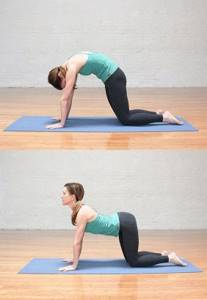
Downward facing dog.
To best understand this pose, simply make a triangle with your body, with the base being the floor. Your legs should be together and your buttocks should be the top point of your triangle. Stay in this position for 30 seconds to a minute.
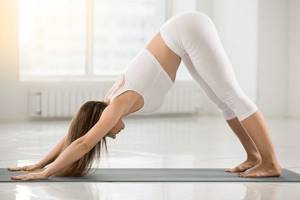
Low lunge forward.
This yoga pose will provide good tone to the lower body. Lunge onto your right leg so that it forms ninety degrees. Stretch your left back and your arms towards the ceiling.
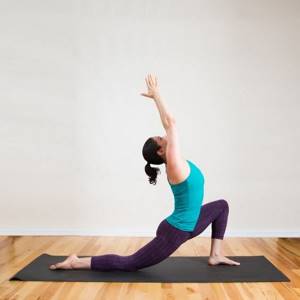
Shoemaker pose.
Sit on the floor and put your legs in a butterfly position. The feet should touch each other. Slowly bend forward and hold Cobbler Pose for as long as you can.
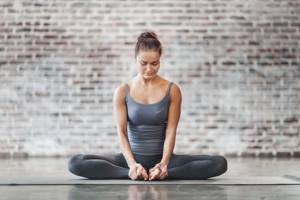
Warrior Pose II.
Good pose for balance and flexibility. Lunge onto your right leg, extend your left leg behind you. Straighten your back and straighten your arms so that they form the letter T.
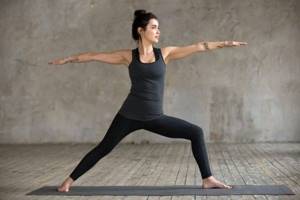
Tree pose.
You've probably seen tree pose a lot because it helps develop balance and strengthen your legs. Stand up straight, shift your weight to your right leg, bend your left leg and place it on the inside of your right thigh. If it’s hard for you, bring it to your calf, most importantly, don’t put pressure on your knee. Keep your hands at your chest in a prayer position. Hold this pose for a minute or two, and then repeat the same with the other leg.
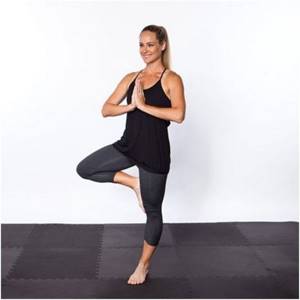
Be patient: how effective is yoga for weight loss?
Bridge Pose.
This position aligns your spine and hips and strengthens your balance. Lie down on the mat, bend your legs and lift your buttocks and back off the floor. Keep your arms at your sides for balance and stability. Hold bridge pose for at least a minute.
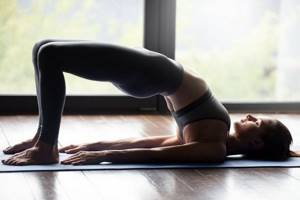
And if you want to learn these and other poses on video, try watching the video of the famous Canadian blogger Cassandra. Just 10 minutes of yoga every morning will provide you with a boost of energy and good mood for the whole day!
Features of yoga and exercise
Exercise is a set of relatively light physical exercises that will help you wake up. Exercises for the main muscle groups are included, but each of them is not specifically worked out. It is very important to choose the right exercise routine for the morning. The fact is that after sleep, the body is still in a relaxed state for several minutes. Unknowingly, it is very easy to damage muscles and pull them. This is why, after exercise, you often feel a heavy feeling in your legs or a sore neck.
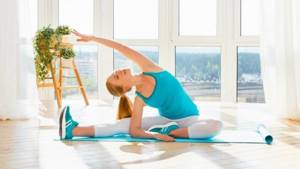
Yoga acts more gently in this regard. The fact is that breathing exercises are carried out first. Sitting comfortably on the mat, a person first feels his breathing, then tunes in to a certain rhythm of the day. After this, he slowly works the main muscle groups, but without putting pressure on them. With the help of a morning yoga routine, it is almost impossible to damage tissue. Yoga is not only physical exercise, but also a certain philosophy. While performing practically meditative techniques, the desired mood for the working day will come, thoughts will form and new ideas will come. In this regard, of course, yoga can be called a more convenient option for morning warm-up.
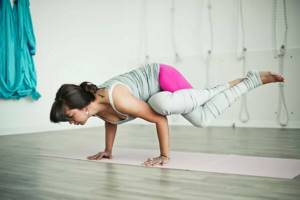
Morning yoga classes: how to choose asanas?
Baddhakonasana. Closed Angle Pose
The classic complex for a morning class is, of course, surya namaskara.
But what other asanas can you diversify it with?
- Bidalasana.
Cat pose . Starting position - on all fours. As you inhale, you need to bend your back and raise your head, while exhaling, you need to arch your back and lower it. Breathing should be slow and calm. The spine moves in waves, the head continues its movement. - Baddhakonasana.
Closed Angle Pose. A more popular name is butterfly. You need to sit on the floor, connect your legs with your feet to each other and pull them towards the perineum. By holding for a long time, you can achieve better hip opening and muscle stretching. During the day, you can ask an instructor or friend to apply pressure to your knees. But in the morning baddhakonasana should be performed passively. - Paschimottanasana.
Rear Stretch Pose. To perform it, you need to sit on your buttocks, stretch your legs in front of you. Inhale, stretch your back, pushing off the floor with your hands, and exhale, bend over, trying to reach your forehead to your knees. Don't force yourself. Holding the pose for a long time will help stretch the hamstrings. Do not round your back, you need to bend over with your back straight!
In general, it is good to practice any poses in which you can passively stretch: ardha padma paschimottanasana, janu sirsasana and the like.
Paschimottanasana. Posterior Stretch Pose










